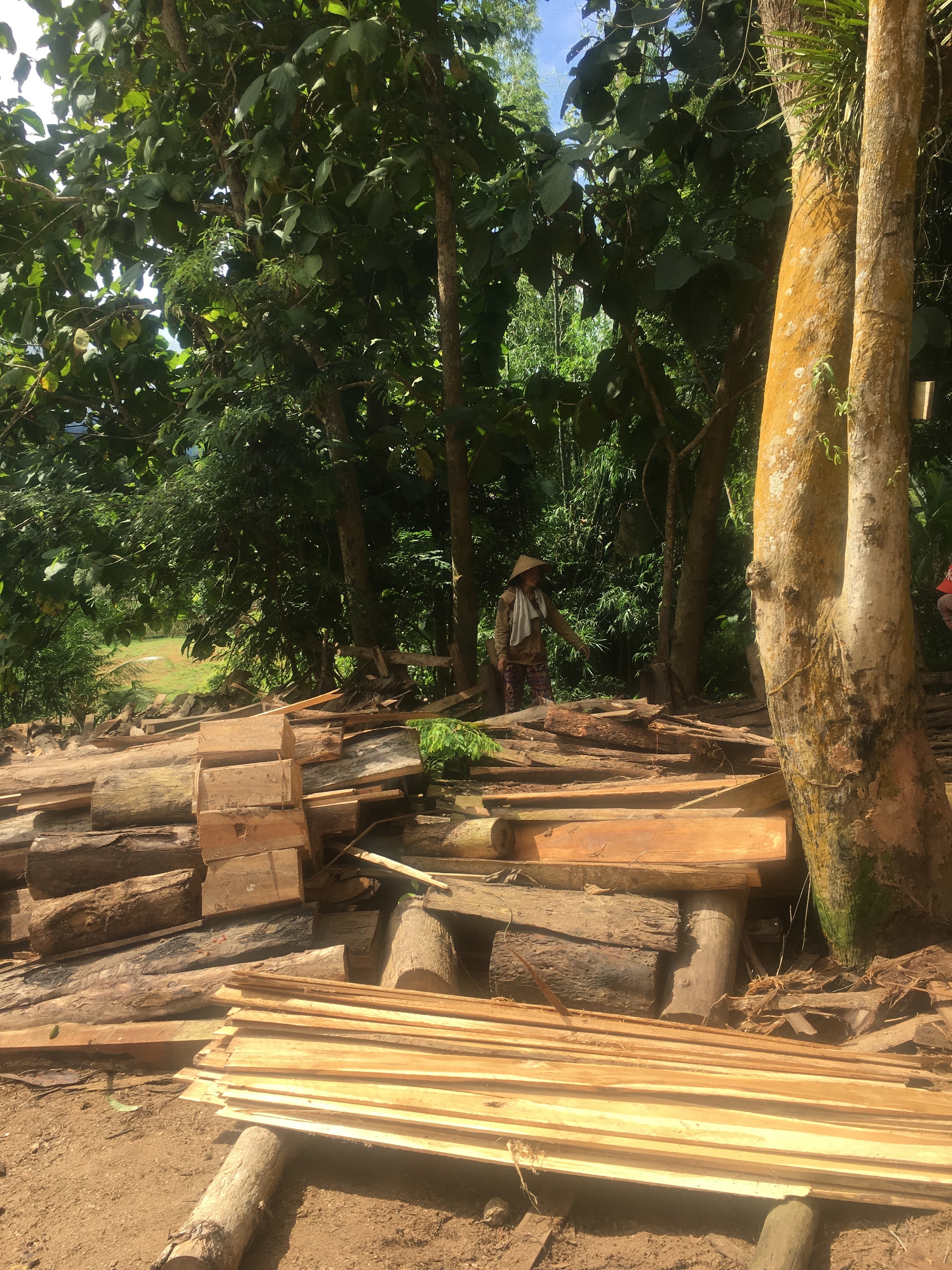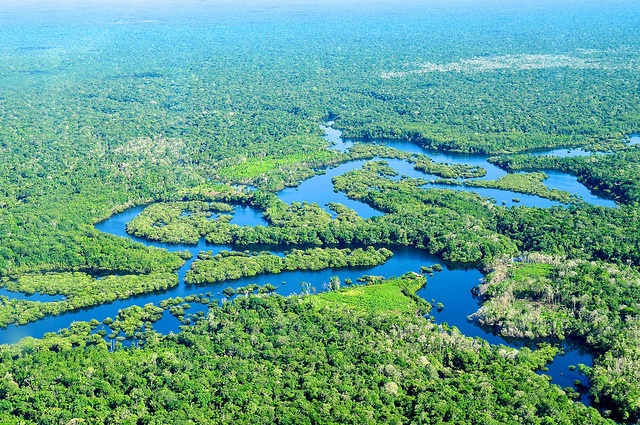benefit-sharing

Being inspired by gender actions in forest landscapes around the world
By Patti Kristjanson (PROFOR) with thanks to Anne Kuriakose (CIF), Meerim Shakirova (FIP), Carlos Cordova (ENR/FIP), Tamara Bah (FCPF), Nicholas Soikan (SURR/FCPF), Haddy Sey (SURR), Margaux Granat (IUCN), Thu Thuy Pham (CIFOR), and Bimbika Basnett (CIFOR)
I recently took this photo of a Laotian woman throwing around pieces of teak wood in a small-scale forest enterprise. This, despite the widespread myth that women are seldom involved in timber and are mostly relegated to gathering forest products. The fact is, we still don’t know much about where and how much women are involved, and more importantly, what opportunities are being missed by largely ignoring half the population living in and around forests. (Oh, and that teak was so cheap, I wanted to take a couple of suitcases of it home with me!)
Just how are forest landscape projects addressing gender-related challenges and opportunities? A recent knowledge-sharing event in Lao PDR, which brought together some 150 participants from over 40 countries, was a good place to pose this question.
We learned that countries as diverse as Laos, Mexico, Ghana, Ecuador, Cameroon, Uganda, and Ghana have been creatively addressing gender constraints and opportunities.
Some specific gender-responsive strategies being pursued in Mexico include creating a gender unit in the main forest agency, and a gender network reaching all states; promoting an institutional culture with a gender perspective; and creating Mexico’s first female fire protection brigade.
Another promising initiative is the Forest Investment Program’s Dedicated Grant Mechanism (DGM), an $80 million program designed and led by representatives of indigenous peoples’ groups and local communities. Indeed, many countries are struggling with how best to make funds available to local communities with promising sustainable forest management and related initiatives.
Meanwhile, Mozambique’s DGM for Local Communities has established a National Steering Committee with several female members - including the Vice President and a representative of the Mozambican Rural Women's Movement - and set a target of at least 40% women’s participation for projects to receive support. Other efforts include promoting systematic community land delimitation and individual titling that is gender-responsive, with both husbands’ and wives’ names registered on land documents.
And in Peru, one-third of DGM funds are targeted to indigenous women’s organizations, right from the design stage. One of the lessons from Peru is that strong ‘umbrella’ indigenous organizations that link to many local communities are extremely helpful, compared to trying to work with many small projects/communities
We also learned at the knowledge-sharing event that the Forest Carbon Partnershp Facility (FCPF), the International Union for Conservation of Nature (IUCN) and others have been supporting national climate change and REDD+ gender action plans in Mexico, Ghana, Uganda, Cameroon, Brazil, Mozambique, and Guatemala. These use participatory, bottom-up approaches along with analyses of legislative and policy frameworks and institutional initiatives on gender and climate change. Implementation is stalling in many places, however, due to a lack of dedicated project funds to gender-targeted activities. In Guatemala, for example, capacity needs and knowledge issues loom large, as in other countries. The need for financial mechanisms for local actors – both men and women – to be able to access private banking resources was also flagged.
In addition, we heard from Nepal, where each parish (50-100 households) has a forest user group whose elected committee must be at least 50% female, and either the vice-president or secretary must be female. Encouragingly, new rules require both women and men to be signatories on bank accounts.
And a key lesson from Vietnam’s REDD+ participatory community-based mapping efforts supported by FCPF is that women’s knowledge is key and must be incorporated into local forest management plans and by-laws on forest use.
It is apparent that many efforts, in many countries, are focused on being more inclusive and making sure women, indigenous peoples, and other less traditionally empowered peoples are involved in REDD+ and other forest-related planning processes. This is a great first step. But we also need to see more innovative and equitable benefit-sharing and empowerment strategies incorporated into forest landscape initiatives. We are starting to see some encouraging examples; it is a challenge well worth accepting.
For stories and updates on related activities, follow us on twitter and facebook , or subscribe to our mailing list for regular updates.
Last Updated : 06-16-2024

Improving social inclusion in debate on REDD+ benefit-sharing in Brazil
CHALLENGE
To control and reduce deforestation in the Amazon, the Brazilian government created the National REDD+ Strategy (NRS), which has provided a framework to compensate entities protecting the Amazon along a jurisdictional scale (states). In 2015, to support the coordination and implementation of the NRS, the Brazilian Government established the National Commission for Reducing Emissions of Greenhouse Gases from Deforestation and Forest Degradation, Conservation of Forest Carbon Stocks, Sustainable Management of Forests and Increase in Carbon Stocks Forestry - REDD + (CONAREDD). Representing federal, state and municipal governments as well as local and civil society organizations, CONAREDD has worked to advance dialogue and cooperation amongst the various stakeholders and members. However, certain representatives of society, including indigenous people, smallholders, and traditional communities are still not fully included in the REDD+ debates. The process of how and to whom the benefits of Brazil’s NRS can be offered and allocated amongst the stakeholders of the Amazon forest states remains largely undetermined and un-informed.
Therefore, there is the need for a healthy debate about the alternatives for benefit-sharing mechanisms for REDD+ that reflects the interests of different social groups in the Amazon. PROFOR’s program seeks to engage with leaders of the Amazon and representatives of the states and federal governments to debate and devise options on benefit sharing that could support the NRS and the REDD+ initiatives of regional states.
APPROACH
PROFOR’s program will work closely with identified local organizations such as the Amazon Environmental Research Institute (IPAM), a Brazilian NGO that will be leading many of the activities, to conduct the following:
- Report on the current benefit-sharing mechanisms being used or proposed in Brazil;
- Apply PROFOR’s Options Assessment Framework with stakeholders during a series of workshops to obtain recommendation on the benefit-sharing mechanism to be applied to Brazil’s context;
- Develop an interim report based on stakeholder´s opinions derived from the Framework results;
- Conduct a final workshop to discuss the benefit-sharing mechanisms identified;
- Draw a best practice guide to implement the mechanisms identified during the workshops.
RESULTS:
- The workshops participants claimed a higher participation of the private sector in the REDD+ process, as a way to reach more robust mechanisms, not only as direct beneficiaries of carbon sequestration but as protagonists in the management of financial mechanisms that can enable a cost-effective forest-based economy. The argument is that the governmental machine has many bureaucracy, lack of agility and lack of transparence that commits the implementation of REDD+.
- Both national and subnational governments need to establish a closer dialogue with local actors, despite the dimensions, access difficulties and multiculturalism characteristic of the Amazon. This dialogue is key to improve their understanding of REDD+ and increase their participation in the whole process.
- Communities, although they are the protagonists of the process, have a marginal involvement so far. A heavy and intense process of leadership strengthening, and capacity building is one of the key measures that needs to be improved.
- The role of NGOs is fundamental in REDD+ initiatives. However, it is not their role to fulfill the obligations of the governments. Besides, NGOs need more resources to increase their capillarity and support more communities.
- The public sector should incorporate the variables of private management in the management of funds. Funds should be managed by the private sector, NGOs or both together.
- The states developed their REDD+ strategies and policies before the federal government. Therefore, a harmonized approach between Federal and State polices will be necessary. Such approach include mutual recognition, equivalency, and reference standards
- The consultations that are made to communities may not be valid since they can reflect better on their consent.
- In a transition to incentive policies for the conservation of forests, the command and control approaches continue to be essential in the routines of environmental agencies.
- Setting up a quality center for intelligence gathering and spatial monitoring is a critical, yet resource intensive task, requiring appropriate equipment and specialized human resources. Only through robust investments can states be able to monitor and deter illicit actions in a timely manner.
- The technology does not replace the human capacity to read the images, especially in natural features that are confused with deforestation and degradation. There is a lack of human resources able to do this job, as well as to exercise command and control actions, once the situations in which they should intervene have been detected.
- There is a major bottleneck in measures to detect and measure environmental degradation in relation to deforestation that needs to be observed.
For stories and updates on related activities, follow us on twitter and facebook , or subscribe to our mailing list for regular updates.
Last Updated : 06-16-2024








